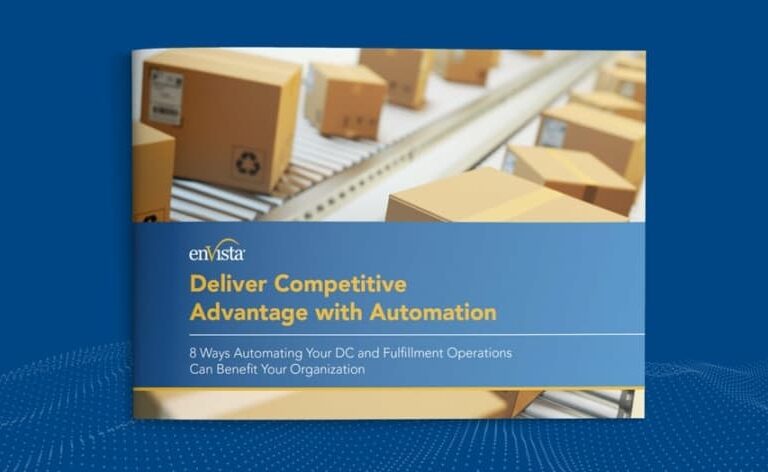Warehouse leaders are always seeking innovative solutions to increase productivity and efficiency in their facilities. In recent years, Robotic Process Automation (RPA) has emerged as a game-changing technology that enables businesses to automate repetitive tasks, streamline processes and drive operational excellence. RPA is a form of robotic integration that has become one of the most fundamental ways to enhance productivity.
Learn more about the key benefits of RPA and how it can revolutionize various industries. By understanding the advantages that RPA offers and leveraging experienced automation consultants like enVista as your expert guides, your organization can make informed decisions about integrating this transformative technology into your operations, unleashing its potential to maximize efficiency and achieve strategic goals.
Understanding Robotic Process Automation
It’s important to understand what Robotic Process Automation is. RPA is a revolutionary technology that leverages software robots or “bots” to automate rule-based, repetitive tasks within business processes. These “bots” perform tasks that emulate human actions, interacting with applications, extracting and manipulating data and executing tasks with speed and precision.
The Benefits of Robotic Process Automation
RPA offers a wide range of benefits. Robotic integration and automation can enhance accuracy and reduce costs. There’s a reason so many organizations harness the power of RPA to improve their organizational efficiency.
Below are eight of the key benefits of RPA:
1. Save Time on Repetitive Tasks
One of the most compelling advantages of RPA is its ability to save time. By automating repetitive tasks, RPA eliminates the need for manual intervention, allowing you to execute processes with unmatched speed and efficiency. RPA lets bots take care of certain tasks much more quickly than a human can.
Bots work tirelessly around the clock, enabling 24/7 task execution and significantly reducing process cycle times. This time-saving capability empowers employees to focus on more strategic initiatives, innovation and critical decision-making, leading to higher productivity and business agility.
2. Increase ROI by Optimizing Resource Allocation
While RPA does require an investment to get started, it also provides an increase in return. RPA offers a compelling return on investment (ROI) by optimizing resource allocation and driving cost savings. By automating manual and repetitive tasks, your organization can significantly reduce labor costs and improve resource utilization.
RPA bots work diligently and with a higher level of accuracy. By removing errors and acting quickly, RPA can save organizations time and money and enhance productivity, directly contributing to a higher ROI. This would enable your organization to reinvest in strategic initiatives and fuel business growth.
3. Eliminate Human Error with Robotic Process Automation
No matter how skilled a human employee is, they will tire and make occasional mistakes. Human error is an inherent risk in manual processes, and it leads to costly mistakes and rework. RPA eliminates the potential for human error by executing tasks with adherence to predefined rules. Because of this, robots can perform processes accurately every time.
By automating routine processes, your organization can achieve consistent results and high data quality, minimizing errors, exceptions and subsequent corrective actions. The reduction in errors not only enhances operational efficiency but also improves customer satisfaction and brand reputation.
4. Mitigate Data Security & Privacy Risks with Enhanced Security Features
Data security and privacy are paramount concerns for organizations across industries. Security protects customers and clients and helps organizations stay compliant. RPA helps mitigate security risks by providing enhanced security features. RPA bots operate within controlled environments, adhering to strict security protocols.
They can securely access applications and databases, perform tasks without human intervention and maintain a comprehensive audit trail of all activities. RPA ensures that sensitive data remains protected, minimizing the risk of unauthorized access, data breaches and compliance violations.
5. Ensure Compliance Through Bots Predefined Rules & Guidelines
Compliance with industry regulations and standards is critical for organizations operating in highly regulated sectors. RPA facilitates compliance by automating processes and ensuring adherence to predefined rules and guidelines.
As long as bots are properly programmed, they will follow all regulations they have in their systems. Bots consistently follow regulatory requirements, reducing the risk of non-compliance and associated penalties. RPA also generates detailed audit logs and reports, providing a comprehensive trail of activities for regulatory audits and demonstrating compliance with industry mandates.
6. Scale Business Process Automation
Scalability is important for any business that plans to expand. One of the distinguishing features of RPA is its scalability. Scalability allows an organization to increase its business without requiring entirely new systems, tools and processes. RPA would ensure that your organization could easily scale its automation efforts to meet evolving business demands.
RPA bots can handle high volumes of tasks without the need for additional resources, allowing you to respond quickly to fluctuating workloads. As business needs grow, bots can take on more work, where a human might not be able to. Automation on its own is already powerful for reducing errors and demand, and the ability to scale these benefits is crucial. This scalability empowers businesses to optimize resource allocation, improve process efficiency and meet customer expectations in dynamic market conditions.
7. Foster Interconnectivity Across Disparate Systems
Interconnectivity empowers organizations to send information across the entire organization without necessitating complicated handoffs and while increasing consistency. RPA acts as a powerful catalyst for integrating disparate systems and applications across an organization. Automating processes serves as a bridge, enabling seamless data transfer, process orchestration and workflow automation.
By integrating various systems, RPA eliminates manual handoffs, reduces data silos and improves data accuracy and consistency. This interconnectivity will help your organization create an agile and cohesive business environment, facilitating collaboration and driving end-to-end process optimization.
8. Boost Employee and Customer Satisfaction
Implementing RPA can significantly enhance employee and customer satisfaction, which are two crucial aspects of a successful business. By automating mundane and repetitive tasks, RPA frees up employees’ time and enables them to focus on higher-value work that requires creativity, critical thinking and problem-solving skills. Teams are able to focus on customer satisfaction instead of performing mundane and repetitive tasks.
This fosters a more fulfilling and engaging work environment, leading to increased employee satisfaction, retention and productivity. Employees are able to perform the work that they find satisfaction from, and customers are able to receive the care and attention they need. Additionally, RPA streamlines processes, reduces errors and enables faster response times, improving customer satisfaction and fostering long-term loyalty.
Implementing RPA Can Transform Your Business
Robotic Process Automation offers transformative benefits, enabling organizations to streamline operations, enhance efficiency and drive sustainable growth. By automating repetitive tasks, reducing errors and optimizing resource allocation, RPA empowers businesses to increase productivity, improve compliance and scale with agility in an evolving digital landscape.
Embracing RPA isn’t just about automation, it’s about unlocking new opportunities for innovation and strategic growth. If you’re ready to harness the power of RPA, our experts are here to guide you through seamless implementation, helping you maximize efficiency and ROI. Contact us today to take the next step in your automation journey.





